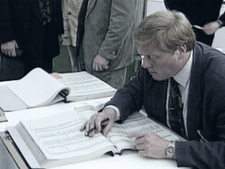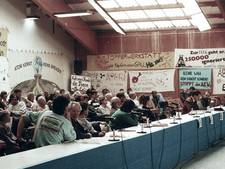Licence and legal bases
It was a long way from the idea to use Konrad as a repository for waste with negligible heat generation until the start of implementation. It took already about 20 years to just have the licence granted, the so-called plan-approval decision.

![]() About 290,000 objectors expressed their concerns before the hearing started
About 290,000 objectors expressed their concerns before the hearing started
The plan-approval procedure for Konrad was a nuclear licensing procedure providing for both an environmental impact assessment and a comprehensive public participation. Objections raised in time by affected citizens and the statements of public-interest bodies were jointly discussed in a hearing. The purpose of public participation is to enable the licensing authority to assess the objections properly in due time. Vital difference compared with earlier repository projects: Before the first waste could be emplaced the operator had to prove in the nuclear licensing procedure that the repository would not pose a risk for man and environment, not even in the future.
1982: Start of plan-approval procedure
After these investigations had concluded, the Federal Institute of Science and Metrology (Physikalisch-Technische Bundesanstalt, PTB) the authority which was responsible for disposal at that time, filed an application for the initiation of a plan-approval (licensing) procedure. Following a comprehensive site-investigation programme, the draft plan was then submitted to 70 authorities and nature conservation organisations for an opinion. The Konrad project was accompanied by intensive public relations work. In May 1983, an “Information Centre for Nuclear Waste Management” opened in Salzgitter for this explicit purpose.
1989: Plan submitted
In early 1989, the PTB submitted the plan to the competent Lower Saxon Environment Ministry (NMU). The NMU confirmed that the plan was suitable to being disclosed to public inspection and prepared the public dissemination.
1991: Disclosure to public inspection – 290,000 objectors take part
For two months the application documents were disclosed to public inspection. Around 290,000 objectors take part in this procedure and submit their claims to the licensing authority.

![]() 1992: The hearing in 75 lasted days
1992: The hearing in 75 lasted days
1992: Hearing
The hearing started on 25 September 1992 in Salzgitter-Lebenstedt and concluded on 6 March 1993 after altogether 75 days.
2002: Granting of the plan-approval decision
The federal state of Lower Saxony granted the plan-approval decision for Konrad in on 22 May 2002.
2007: Confirmation by court
Eight actions were initiated against the decision by communities, rural districts, churches and private individuals. The churches and rural districts withdrew their actions later on. On 8 March 2006, the Lüneburg Higher Administrative Court dismissed the actions and did not admit a revision. This was confirmed by the Federal Administrative Court on 26 March 2007. Thus, the decisions of the Higher Administrative Court in Lüneburg are legally binding, the plan-approval decision is effective and enforceable.
State of 2017.03.30

